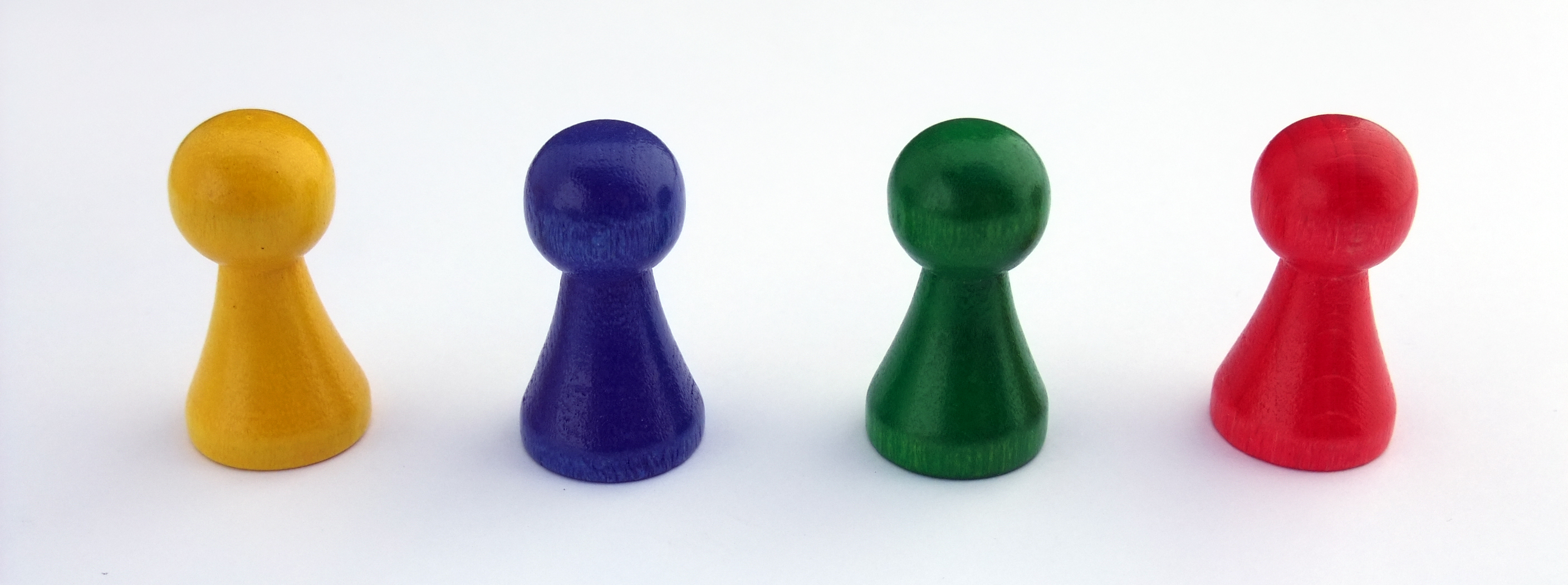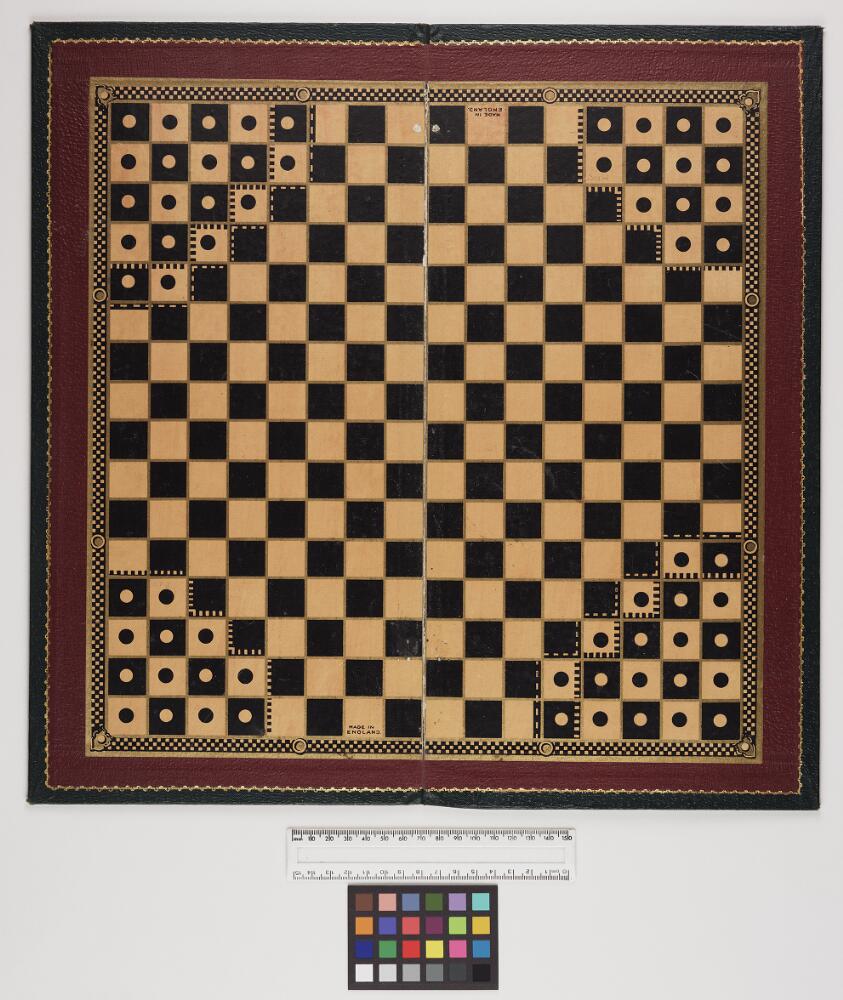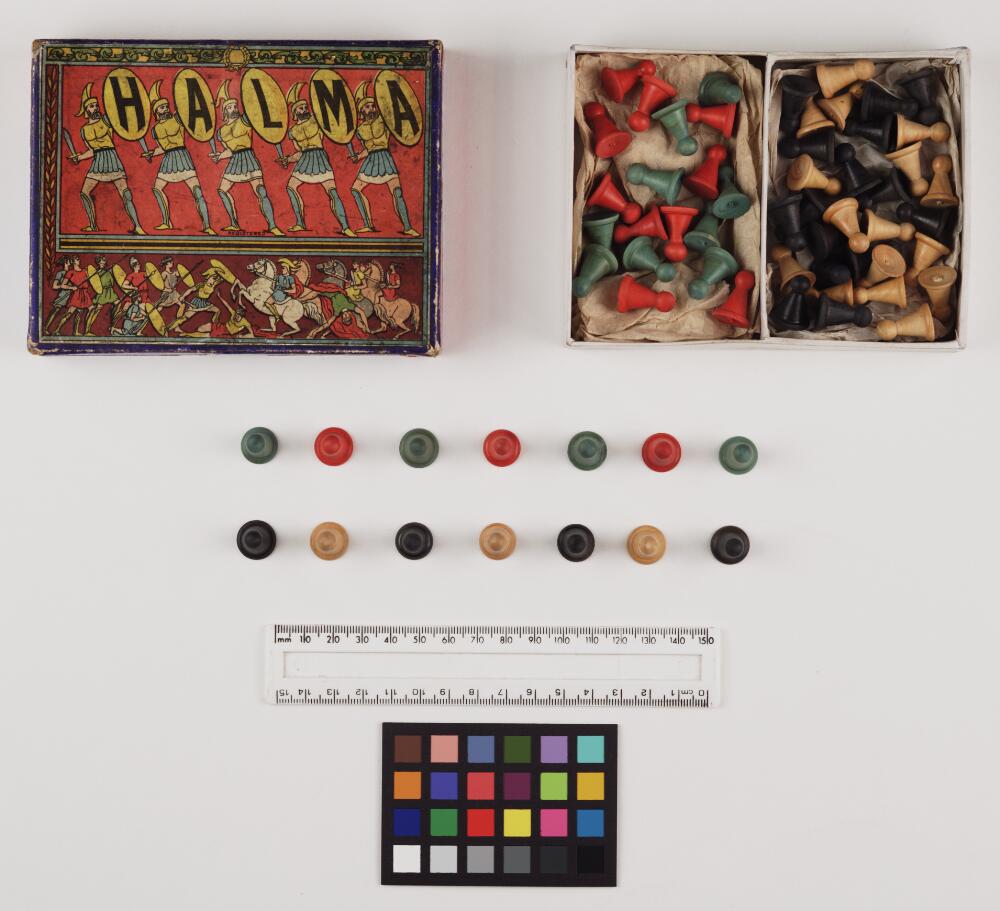Halma on:
[Wikipedia]
[Google]
[Amazon]
Halma (from the Greek word ἅλμα meaning "jump") is a
 * The board consists of a grid of 16×16 squares.
* Each player's ''camp'' consists of a cluster of adjacent squares in one corner of the board. These camps are delineated on the board.
** For two-player games, each player's camp is a cluster of 19 squares. The camps are in opposite corners.
** For four-player games, each player's camp is a cluster of 13 squares. Each of the four corners of the board is a camp.
* Each player has a set of pieces in a distinct color, of the same number as squares in each camp.
* The game starts with each player's camp filled by pieces of their own color.
* The board consists of a grid of 16×16 squares.
* Each player's ''camp'' consists of a cluster of adjacent squares in one corner of the board. These camps are delineated on the board.
** For two-player games, each player's camp is a cluster of 19 squares. The camps are in opposite corners.
** For four-player games, each player's camp is a cluster of 13 squares. Each of the four corners of the board is a camp.
* Each player has a set of pieces in a distinct color, of the same number as squares in each camp.
* The game starts with each player's camp filled by pieces of their own color.
 * Players randomly determine who will move first.
* Pieces can move in eight possible directions (orthogonally and diagonally).
* Each player's turn consists of moving a single piece of one's own color in one of the following plays:
** One ''move'' to an empty square:
*** Place the piece in an empty adjacent square.
*** This move ends the play.
** One or more ''jump''s over adjacent pieces:
*** An adjacent piece of any color can be jumped if there is an adjacent empty square on the directly opposite side of that piece.
*** Place the piece in the empty square on the opposite side of the jumped piece.
*** The piece that was jumped over is unaffected and remains on the board.
*** After any jump, one may make further jumps using the same piece, or end the play.
* Once a piece has reached the opposing camp, a play cannot result in that piece leaving the camp.
* If the current play results in having every square of the opposing camp occupied by one's own pieces, the acting player wins. Otherwise, play proceeds clockwise around the board.
* Players randomly determine who will move first.
* Pieces can move in eight possible directions (orthogonally and diagonally).
* Each player's turn consists of moving a single piece of one's own color in one of the following plays:
** One ''move'' to an empty square:
*** Place the piece in an empty adjacent square.
*** This move ends the play.
** One or more ''jump''s over adjacent pieces:
*** An adjacent piece of any color can be jumped if there is an adjacent empty square on the directly opposite side of that piece.
*** Place the piece in the empty square on the opposite side of the jumped piece.
*** The piece that was jumped over is unaffected and remains on the board.
*** After any jump, one may make further jumps using the same piece, or end the play.
* Once a piece has reached the opposing camp, a play cannot result in that piece leaving the camp.
* If the current play results in having every square of the opposing camp occupied by one's own pieces, the acting player wins. Otherwise, play proceeds clockwise around the board.
 There are also 8×8 and 10×10 board variations, either of which is adequate for two players and they have 10 and 15 pieces per player, respectively. There are various online versions, usually for two-player, turn-based play.
There are also 8×8 and 10×10 board variations, either of which is adequate for two players and they have 10 and 15 pieces per player, respectively. There are various online versions, usually for two-player, turn-based play.
 Some sites implement a rule variation stating that a player automatically loses if they still have a piece in their start region after a certain number of moves (typically 30 for the 8×8 game, 50 for the 10×10 game). Fast-advancing players occasionally attempt to blockade an opposing piece, but this tactic can backfire if the other player is aware of it. In non-electronic versions, the number of moves is not normally counted.
Some sites implement a rule variation stating that a player automatically loses if they still have a piece in their start region after a certain number of moves (typically 30 for the 8×8 game, 50 for the 10×10 game). Fast-advancing players occasionally attempt to blockade an opposing piece, but this tactic can backfire if the other player is aware of it. In non-electronic versions, the number of moves is not normally counted.
 * Talking Halma pieces featured in the Rupert the Bear story "Rupert and the Jumping Men," Rupert Annual 1976.
* In E. Nesbit's '' The Magic City'', the land of Somnolentia is inhabited by Halma people.
* Mervyn Peake twice compares distant people to halma pieces, in his novels ''
* Talking Halma pieces featured in the Rupert the Bear story "Rupert and the Jumping Men," Rupert Annual 1976.
* In E. Nesbit's '' The Magic City'', the land of Somnolentia is inhabited by Halma people.
* Mervyn Peake twice compares distant people to halma pieces, in his novels ''
American Games: A Historical Perspective, by Bruce Whitehill. Leiden, The Netherlands: ''Board Games Studies, Vol. 2'', CNWS Publications, 1999.
"Halma" for Android
Rules for the Game of Halma, Copyright 1938 by Parker Brothers, Inc. Salem, Mass., New York, Chicago and London
* {{Authority control Board games introduced in the 1880s Abstract strategy games
strategy
Strategy (from Greek στρατηγία ''stratēgia'', "art of troop leader; office of general, command, generalship") is a general plan to achieve one or more long-term or overall goals under conditions of uncertainty. In the sense of the " a ...
board game
Board games are tabletop games that typically use . These pieces are moved or placed on a pre-marked board (playing surface) and often include elements of table, card, role-playing, and miniatures games as well.
Many board games feature a ...
invented in 1883 or 1884 by George Howard Monks, an American thoracic surgeon at Harvard Medical School
Harvard Medical School (HMS) is the graduate medical school of Harvard University and is located in the Longwood Medical and Academic Area, Longwood Medical Area of Boston, Massachusetts. Founded in 1782, HMS is one of the oldest medical schools ...
. His inspiration was the English game ''Hoppity'' which was devised in 1854.
The gameboard is checkered and divided into 16×16 squares. Pieces may be small checkers or counters, or wooden or plastic cones or men resembling small chess pawns. Piece colors are typically black and white for two-player games, and various colors or other distinction in games for four players.
Overview
The game is played by two or four players seated at opposing corners of the board. The game is won by being first to transfer all of one's pieces from one's own camp into the camp in the opposing corner. For four-player games played in teams, the winner is the first team to race both sets of pieces into opposing camps. On each turn, a player either moves a single piece to an adjacent open square, or jumps over one or more pieces in sequence.Rules
Setup
 * The board consists of a grid of 16×16 squares.
* Each player's ''camp'' consists of a cluster of adjacent squares in one corner of the board. These camps are delineated on the board.
** For two-player games, each player's camp is a cluster of 19 squares. The camps are in opposite corners.
** For four-player games, each player's camp is a cluster of 13 squares. Each of the four corners of the board is a camp.
* Each player has a set of pieces in a distinct color, of the same number as squares in each camp.
* The game starts with each player's camp filled by pieces of their own color.
* The board consists of a grid of 16×16 squares.
* Each player's ''camp'' consists of a cluster of adjacent squares in one corner of the board. These camps are delineated on the board.
** For two-player games, each player's camp is a cluster of 19 squares. The camps are in opposite corners.
** For four-player games, each player's camp is a cluster of 13 squares. Each of the four corners of the board is a camp.
* Each player has a set of pieces in a distinct color, of the same number as squares in each camp.
* The game starts with each player's camp filled by pieces of their own color.
Play sequence
Comparison to other games
* The mechanic of jumping pieces is reminiscent ofdraughts
Checkers (American English), also known as draughts (; British English), is a group of strategy board games for two players which involve diagonal moves of uniform game pieces and mandatory captures by jumping over opponent pieces. Checkers ...
(checkers) but differs in that no opposing pieces are ever captured or otherwise withdrawn from the board nor is jumping compulsory.
* Chinese Checkers, a variant of Halma, was originally published in 1892 as ''Stern-Halma'' (German for "Star Halma") and later renamed upon marketing to the United States
The United States of America (U.S.A. or USA), commonly known as the United States (U.S. or US) or America, is a country primarily located in North America. It consists of 50 U.S. state, states, a Washington, D.C., federal district, five ma ...
to appear more exotic. The name is misleading, since the game has no historical connection with China, nor is it a checkers game.
Variations
 There are also 8×8 and 10×10 board variations, either of which is adequate for two players and they have 10 and 15 pieces per player, respectively. There are various online versions, usually for two-player, turn-based play.
There are also 8×8 and 10×10 board variations, either of which is adequate for two players and they have 10 and 15 pieces per player, respectively. There are various online versions, usually for two-player, turn-based play.
 Some sites implement a rule variation stating that a player automatically loses if they still have a piece in their start region after a certain number of moves (typically 30 for the 8×8 game, 50 for the 10×10 game). Fast-advancing players occasionally attempt to blockade an opposing piece, but this tactic can backfire if the other player is aware of it. In non-electronic versions, the number of moves is not normally counted.
Some sites implement a rule variation stating that a player automatically loses if they still have a piece in their start region after a certain number of moves (typically 30 for the 8×8 game, 50 for the 10×10 game). Fast-advancing players occasionally attempt to blockade an opposing piece, but this tactic can backfire if the other player is aware of it. In non-electronic versions, the number of moves is not normally counted.
Basic strategy and tactics
A game of Halma has three distinct phases. The beginning (before opposing pieces come into contact) is usually a set-piece battle, with players setting up their favoured openings. The middle (when opposing pieces are blocking or jumping each other) is usually characterised by opportunistic play; the player with the most patience to check the whole board for opportunities, including those gained by moving backwards in order to move forwards, will gain an advantage. Players should also set up for the endgame (when opposing pieces have passed one another and must run for home), avoiding stragglers. As with most board games, early control of the center is a key tactic, as it provides additional mobility. Pieces can form a two-layer blocking wall, deflecting the opponent from the center and forcing them into a longer trajectory; however, if the opponent builds an adjacent wall, then the first player to disband his wall usually suffers a strategic disadvantage. It is important to understand that paired pieces move faster than single pieces in the endgame. This means that a player with a pair of "leapfrogging" pieces has an advantage over a player with two individual stragglers. The larger boards have more strategic combinations available than the smaller boards, and the four player game offers more tactical intrigue than the two player game.Notable appearances in popular culture
 * Talking Halma pieces featured in the Rupert the Bear story "Rupert and the Jumping Men," Rupert Annual 1976.
* In E. Nesbit's '' The Magic City'', the land of Somnolentia is inhabited by Halma people.
* Mervyn Peake twice compares distant people to halma pieces, in his novels ''
* Talking Halma pieces featured in the Rupert the Bear story "Rupert and the Jumping Men," Rupert Annual 1976.
* In E. Nesbit's '' The Magic City'', the land of Somnolentia is inhabited by Halma people.
* Mervyn Peake twice compares distant people to halma pieces, in his novels ''Mr Pye
''Mr Pye'' is a 1953 novel by English novelist Mervyn Peake.
Plot
Mr. Pye travels to the Channel Island of Sark to awaken a love of God in all the islanders. His landlady on the island, Miss Dredger, quickly becomes a devout follower of his tea ...
'' and '' Titus Groan''.
* Paul Jennings described the hilarious results of his attempt to decipher the rules of the game from a set of instructions in German in his article "How to Spiel Halma".
* Rickie plays Halma against himself as a lonely child in the novel The Longest Journey by E.M.Forster.
* Eleanor Farjeon talks about playing Halma in her autobiography ''A Nursery in the Nineties'', and about using black, white, and red Halma pieces to enact a Christmas Eve ritual game in which imaginary characters try to climb a mountain made of Anchor Stone Blocks.
* In ''The Chalet School and Jo'' from the Chalet School series by Elinor Brent-Dyer, Halma is played by two of the characters.
* In Episode 9 of the original radio series, ''The Hitchhiker's Guide to the Galaxy'' by Douglas Adams
Douglas Noel Adams (11 March 1952 – 11 May 2001) was an English author and screenwriter, best known for ''The Hitchhiker's Guide to the Galaxy''. Originally a 1978 BBC radio comedy, ''The Hitchhiker's Guide to the Galaxy'' developed into a " ...
, Eddie, the overly cheerful computer of starship, ''Heart of Gold'', tries to calm the crew facing imminent, certain death at the hands of an approaching Vogon fleet, by suggesting that they play electronic Halma.
* Halma is mentioned in Terry Pratchett
Sir Terence David John Pratchett (28 April 1948 – 12 March 2015) was an English humourist, satirist, and author of fantasy novels, especially comic fantasy, comical works. He is best known for his ''Discworld'' series of 41 novels.
Pratchet ...
's Unseen Academicals
*George Sherston, the narrator of Siegfried Sassoon's '' Memoirs of an Infantry Officer'', becomes frustrated when his Aunt suggests a game of Halma at a point when he is consumed by anti-war feeling.
*Halma is mentioned in Compton Mackenzie's ''Rich Relatives.''
*Halma is mentioned in O. Douglas
Anna Masterton Buchan (24 March 1877 – 24 November 1948) was a Scottish novelist who wrote under the pen name O. Douglas. Most of her novels were written and set between the wars and portrayed small town or village life in southern Scotland, ...
's ''Eliza For Common.''
* In Joan Lindsay
Joan à Beckett Weigall, Lady Lindsay (16 November 189623 December 1984) was an Australian novelist, playwright, essayist, and visual artist. Trained in her youth as a painter, she published her first literary work in 1936 at age forty under a ...
's '' Picnic at Hanging Rock'', Halma is one of the games (along with Snakes and Ladders) played by two of the characters during a summer courtship.
* In Lawrence Durrell's 'The Black Book'.
* In E.M. Forster's '' Maurice''.
* In Evelyn Waugh's '' Brideshead Revisited'', Lady Julia Flyte refers to playing Halma with the family's nanny (p. 76).
* In Evelyn Waugh's '' Black Mischief'', Sir Samson Courteney, The British Envoy, cries out when the Legation is being besieged "It's no good. My heart is ''not'' in halma this evening." .“Black Mischief”, Chapter VII.
See also
*Ugolki
Ugolki (, russian: уголки}, English: ''corners'') is a two-player board game, similar to halma, that is typically played on an 8×8 grid board with 16 game pieces per player. It is said to have been invented in Europe in the late 18th cent ...
References
Bibliography * * Whitehill, Bruce. "Halma and Chinese Checkers: Origins and Variations." Fribourg, Switzerland: Step by Step, Proceedings of the 4th Colloquium of Board Games in Academia, Editions Universitaires Fribourg, 2002.Further reading
American Games: A Historical Perspective, by Bruce Whitehill. Leiden, The Netherlands: ''Board Games Studies, Vol. 2'', CNWS Publications, 1999.
External links
"Halma" for Android
Rules for the Game of Halma, Copyright 1938 by Parker Brothers, Inc. Salem, Mass., New York, Chicago and London
* {{Authority control Board games introduced in the 1880s Abstract strategy games